BISC208 Lab Exam - Darwinian Snails, Hardy-Weinberg, Angiosperms, Plant Transpiration, and Predator-Prey Ecology
1/104
There's no tags or description
Looks like no tags are added yet.
Name | Mastery | Learn | Test | Matching | Spaced |
|---|
No study sessions yet.
105 Terms
What is Evolution?
The change in heritable traits of biological populations over generations
How does Evolution Occur?
Can be driven by various mechanisms such as
natural selection
mutation
genetic drift
gene flow
It is not intentional and occurs in populations
What is important to note that Evolution does not account for?
Evolution does NOT occur in induviduals (in populations instead)
It NOT an intentional process
What are the three requirements for Evolution by Naural Selection?
Variation
Inheritance (heredity)
Selection of reproductive success
What does ‘Variance’ mean when talking about the process of Evolution by Natural Selection?
The trait must be variable in the population for evolution to occur by natural selection
Because natural selection acts upon differences in a pop, and favors those who have an advantage to survive
What does ‘Heritability’ mean when talking about the process of Evolution by Natural Selection?
The trait must be heritable for evolution to occur by natural selection because the trait is based on genetic makeup and is passed down to future generations
What does ‘Differential Reproductive Success’ mean when talking about the process of Evolution by Natural Selection?
Induviduals with certain traits are more likely to survive and reproduce at higher rates, ensuring that benefitial traits become more prevelant in a pop over time
Why must a trait have Variance for evolution to occur by natural selection?
Because natural selection acts on variation, and favors induviduals with traits that will lead to higher survival and reproductive rates
Why must a trait be Heritable for evolution to occur by natural selection?
Because for the trait to be passed down from generations, you have to receive your genetic makeup from the previous generation
Why must Selection of a trait occur for Evolution to occur by Natural Selection?
Induviduals who have certain traits are more likely to survive and reproduce, which will pass on the trait
What is Natural Selection?
A key mechanism for evolution, where organisms with traits better suited for the enviornment survive and reproduce more successfully, passing on the traits to their offspring
What is Mutation in Evolution?
A change in the DNA sequence of an organism
can be harmful, beneficial, or have no effect
What is Genetic Drift in Evolution?
A random change in the frequences of different gene versions (alleles) within a population over generations
occurs randomly, unlike natural selection
What is Gene Flow in Evolution?
The transfer of genetic material (alleles) from one population to another by the movement of induviduals between populations, increasing genetic diversity
What is important to note about Mutations (effects)?
Mutations can be harmful, benefical or have no effect on the induvidual
How does Mutation affect Evolution by Natural Selection?
Mutations allow for new variation by the introduction of new alleles (genetic variation)
the only way new alleles can be created within a population
How would shell thickness chang over time if crabs can more easily eat thinner-shelled snails?
Over populations, the shell-thickness within the populations would increase because natural selection would favor snails with thicker shells
more able to reproduce and survive at higher rates
How would the average speed of a population of deer change over time, if predators can more eaisly catch the slower deer?
The average speed of the deer would likely increase over time. With natural selection, the faster deer are more likely to survive and reproduce and pass on advantageous traits to their offspring
In the ‘Clam Simulation’ what was the gene/traits in clams studied?
One gene codes for a sodium channel that is sensitive to Saxitoxin
The other gene codes for an altered sodium channel that is resistant to Saxitoxin (Mutated Gene)
How do the two different versions of the gene affect the clams ability to survive a red tide algal bloom?
The mutated gene that alters the sodium channel protein blocks the Saxitoxin and allows them to survive in the presence of it. (Clams more likely to survive)
The other version of the gene is sensitive to Saxitoxin, and clams with this gene are less likely to survive.
What are the conditions for a population in Hardy-Wineberg Equilibrum?
Is very large and has random mating
Has no migration (gene flow)
Is not experiencing natural selection
Is not experiencing genetic drift (random changes in allele frequiences
Has no intro of new alleles through mutation
What is Hardy-Weinberg Equilibrium?
A principle that states that genetic variation in a population will remain constant under specific conditions (NOT evolving)
What does the Hardy-Weinberg Equilibrum act as in an Evolution experiment?
It acts as the Null Hypothesis, and expresses what the observed allele and geneotype frequencies in a population NOT experiencing evolution should be
What is the purpose of comparing simulated population’s genotype frequiences to those predicted by the Hardy-Weinberg Equilibrium?
It helps determine whether the population is experiencing Evolution.
Since the Hardy-Weinberg is the null hypothesis, we can compare genotype frequiences in a population to it.
What are the differences between Genetic Drift and Natural Selection?
Natural selection favors induviduals with advantageous genotypes/traits, leading to an increased representation in the population.
While Genetic drift is a random event and process that can cause allele frequienes to change, even if the allele is not advantgeous
What are the difference in Natural Selection and Genetic Drift, in terms of the types of events that the clam population may experience?
Genetic Drift involves random changes in allele frequiences due to chance events. Such as Founders Effect, and a Bottleneck event (losses of genetic diversity)
Natural Selection favors induviduals with traits that enhance surviual and reproduction
What is a ‘Bottleneck’ event?
A significant and sudden reduction in a populations size, leading to a loss of genetic diversity (type of Genetic Drift)
natural disasters, disease, or human activites
What is ‘Founders Effect’?
A new population is established by a small group of induviduals leaving a larger population, leading to a possible reduction in genetic diversity (tpye of Genetic Drift)
What does the (p + q = 1) equation represent?
p = allele frequenct for the resistant allele (R) - dominant
q = allele frequency for the sensitive allele (S)
the frequienes equal to 1, the population size
What does the (p² + 2pq + q² = 1) equation represent?
p² = frequency of the genotype RR
2pq = frequenct of the genotype RS
q² = frequency of the genotype SS
How do you find Phenotye Frequencies of the clams with the equation (p² + 2pq + q² = 1) ?
p² = RR allele freq.
2pq = RS allele freq.
q² = SS allele freq.
Since R is dominant, add p² + 2pq, to get the clams that are resistant to Saxitoxin
q², is the clams that are sensitive to Saxitoxin
How do you interpret the results of a Chi-square test?
If the computed Chi-square value is greater than the critical value, it indicates a statistically significant difference between observed and expected counts
If the Chi-square value is less than the critical valye, there is not a statistically significat difference (supports the null hypothesis - no evolution occured)
What is Paralytic Shellfish Poisoning?
When humans are posioned from eating clams that have accumulated Saxitoxin in their cells.
comes from eating clams resistant to Saxitoxin
Paralytic Shellfish Posioning happens from what Clams?
Eating Clams that are resistant to Saxitoxin, because the clams that arent resistant (SS allele frequency) die so they cannot accumulate the toxin.
What is the relationship between red tide algal blooms and Paralytic Shellfish Poisoning (PSP) in humans?
Red Tide Algal Blooms can cause and increase PSP poisoning instances, because the resistant clams accumulate the Saxotoxin in thier cells
If a location experiences more red tide algal bloom events, will the clam populations have a higher frequency of sensitive or resistant alleles?
A higher frequency of resistant alleles in the population
Say a group runs this simulation and at the end, their population shows an allele frequency of R=0.43 and S=0.57. Their Chi-square value is 3.05. What can the group conclude about their population based on these results? (critical value = 3.84)
The Chi-square value indicates the population is in equilibrium, so it did not evolve by natural selection or by genetic drift
Do locations that have a history of Paralytic Shellfish Poisoning typically have a higher percentage of resistant phenotype clams or sensitive phenotype clams?
The sites that have a history of PSP have a higher percentage of clams with resistant phenotypes because natural selection favored clams with that resistant gene.
What are the three basic components of an Angiosperm?
Root System
Shoot System
and Leaves
What is the Root System of an Angiosperm?
Consists of a central Taproot and many Lateral Roots, and they secure the plant and provide it with nutrients and water from the soil

What is the Shoot System of an Angiosperm?
The main body of the plant, through which water and nutrients are transported into vascular tissue
the leaf is the main part of the shoot system
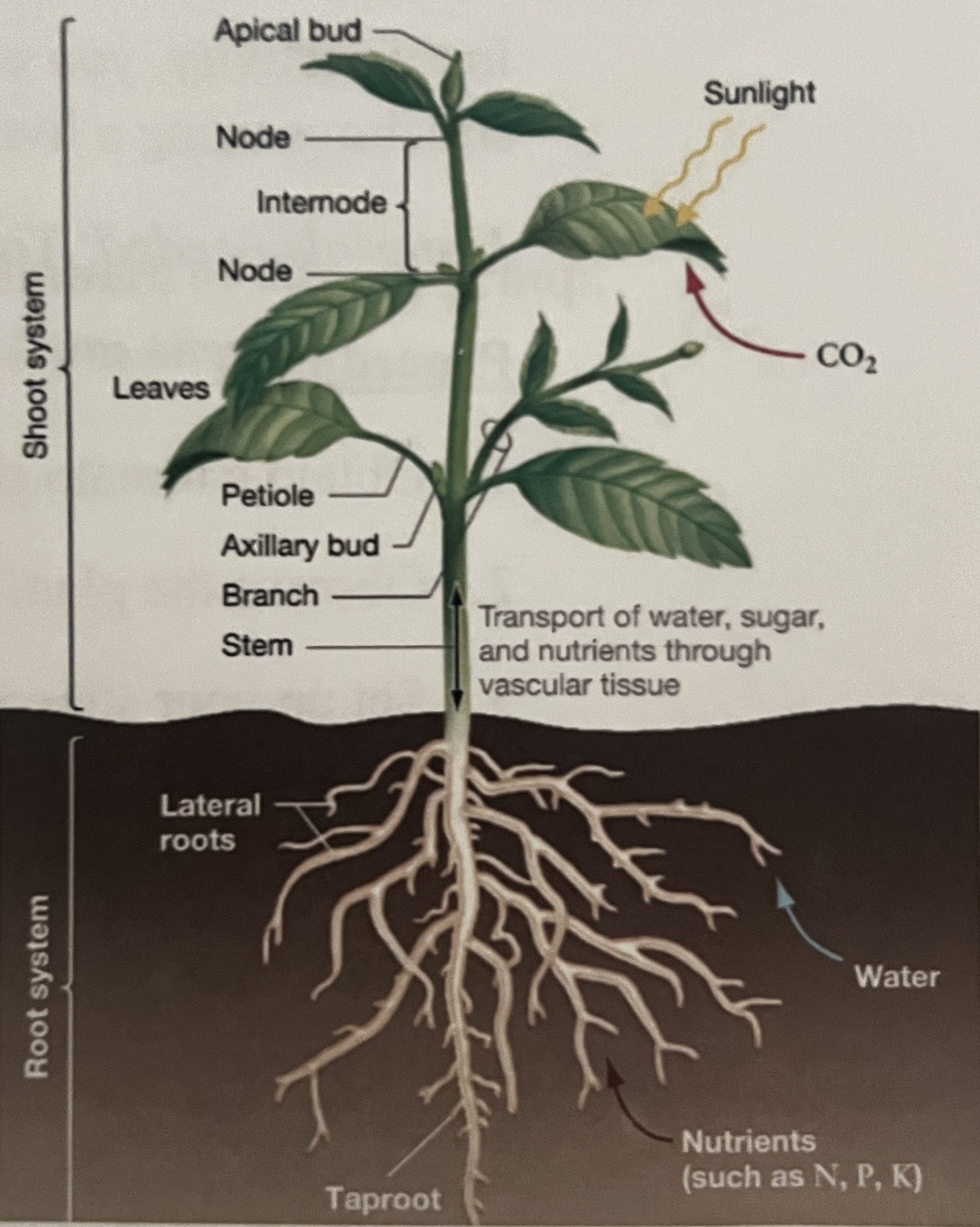
What is the function of a Stem on an Angiosperm?
To support the plant, holding leaves and flowers in a position to maximize sunlight exposure and pollination

What is the function of a Petiole on an Angiosperm?
To connect the Leave to the Stem, provide support and transport of nutrients

What is the function of a Node on an Angiosperm?
Transport of essential nutrients, water, and sugars
is where the petiole meets the stem
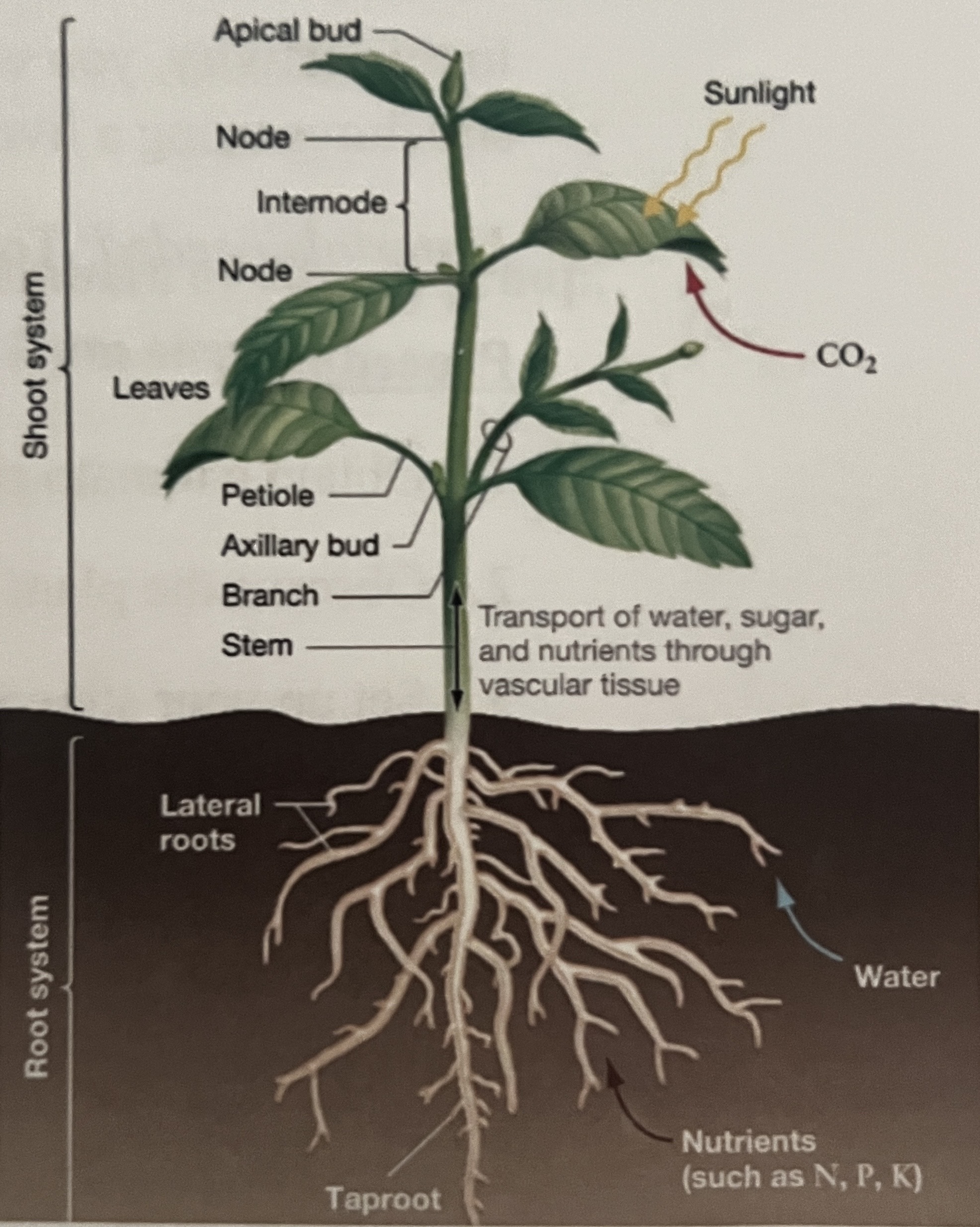
What is the function of a Leave on an Angiosperm?
This is where photosynthesis occurs (where light energy is converted into chemical energy in the form of sugars)

What is the funciton of the Apical Bud on an Angiosperm?
Responsible for the plants primary growth, the growth of the shoot and increase in height
located at the tip of the main stem (shoot) or branches
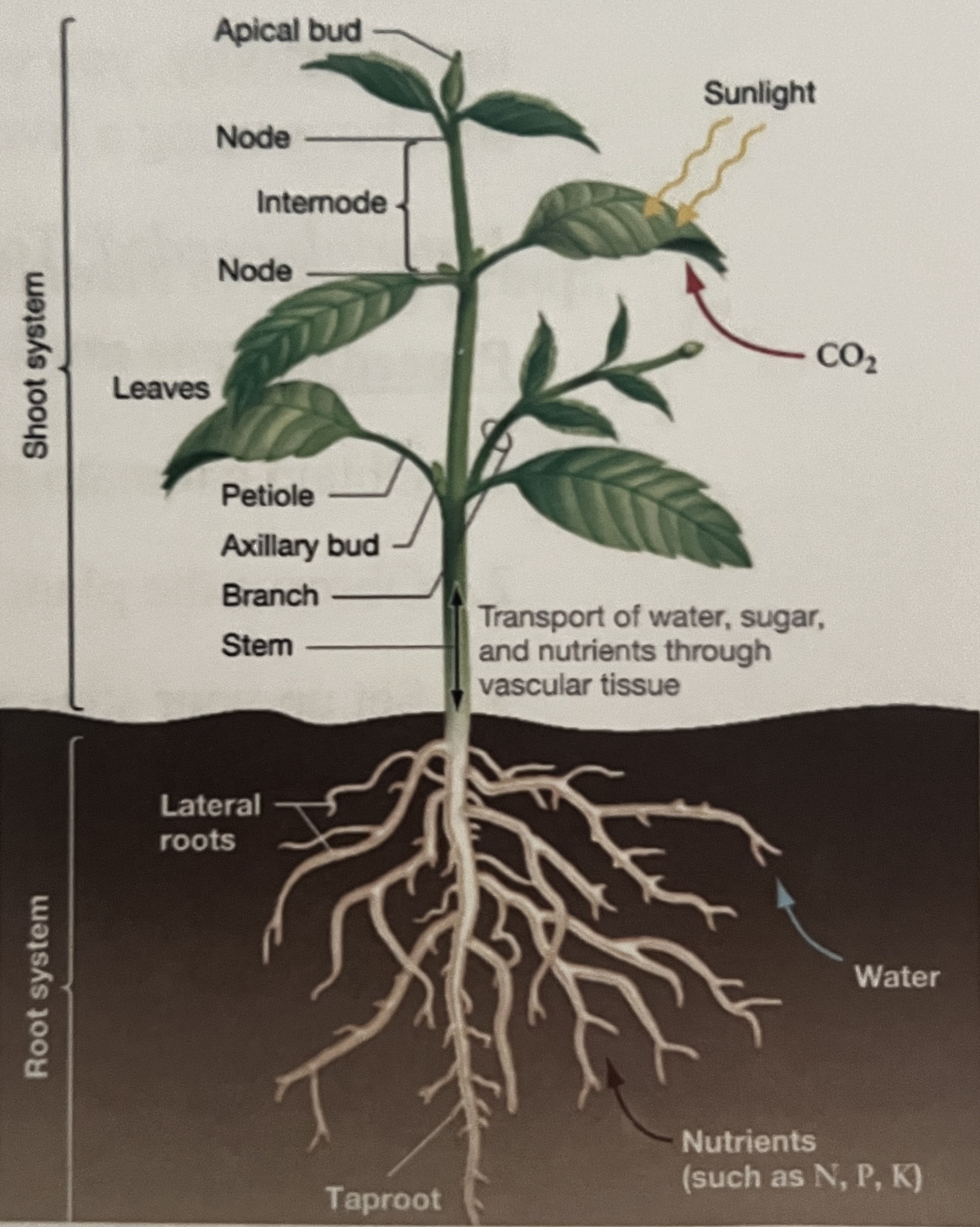
What is the function of the Lateral Root on an Angiosperm?
To anchor the plant, and increase the surface are for water and nutrient absorption
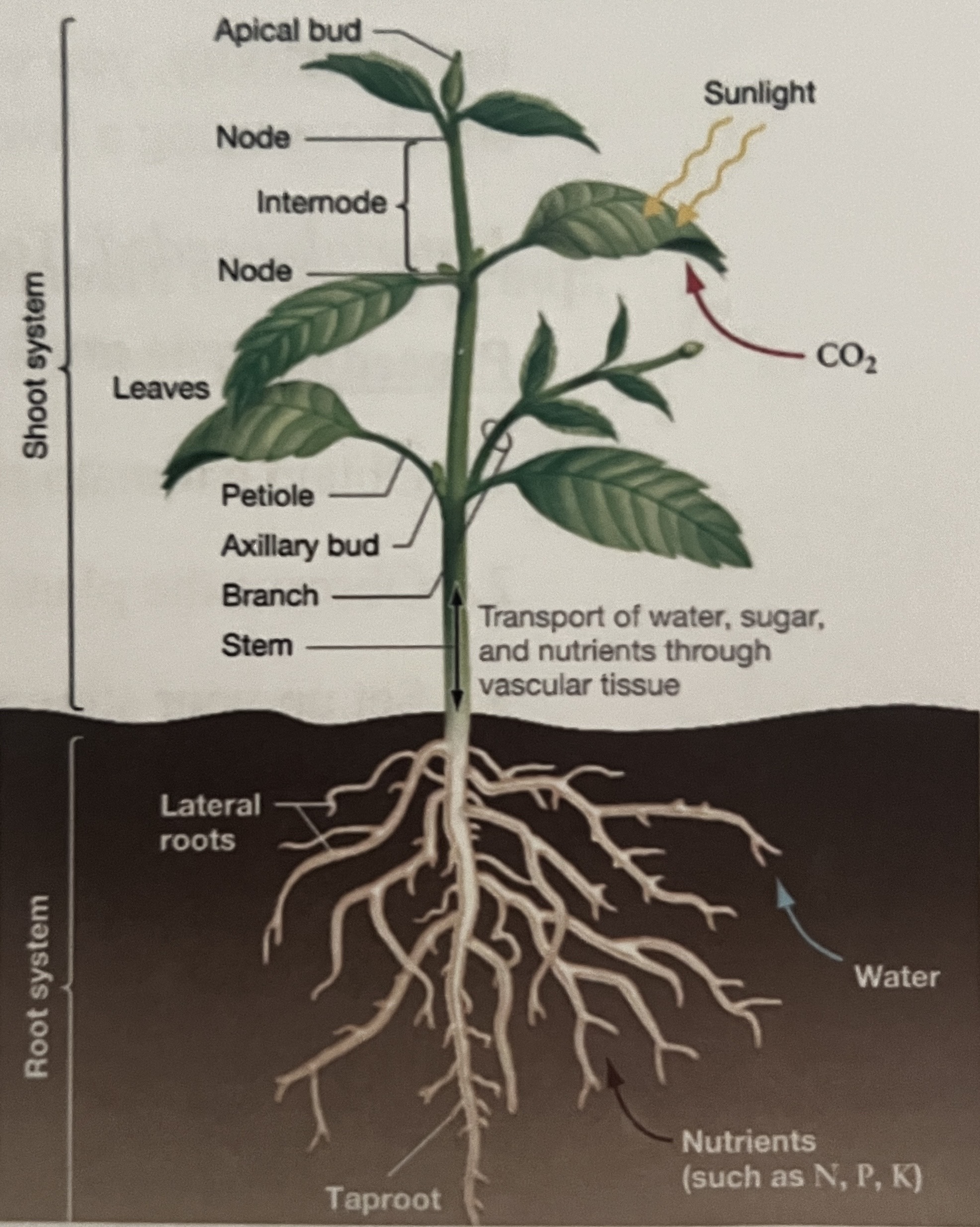
What is the function of the Tap Root on an Angiosperm?
Provide strong anchorage for the plant, and to facilitate water and nutrient absorption
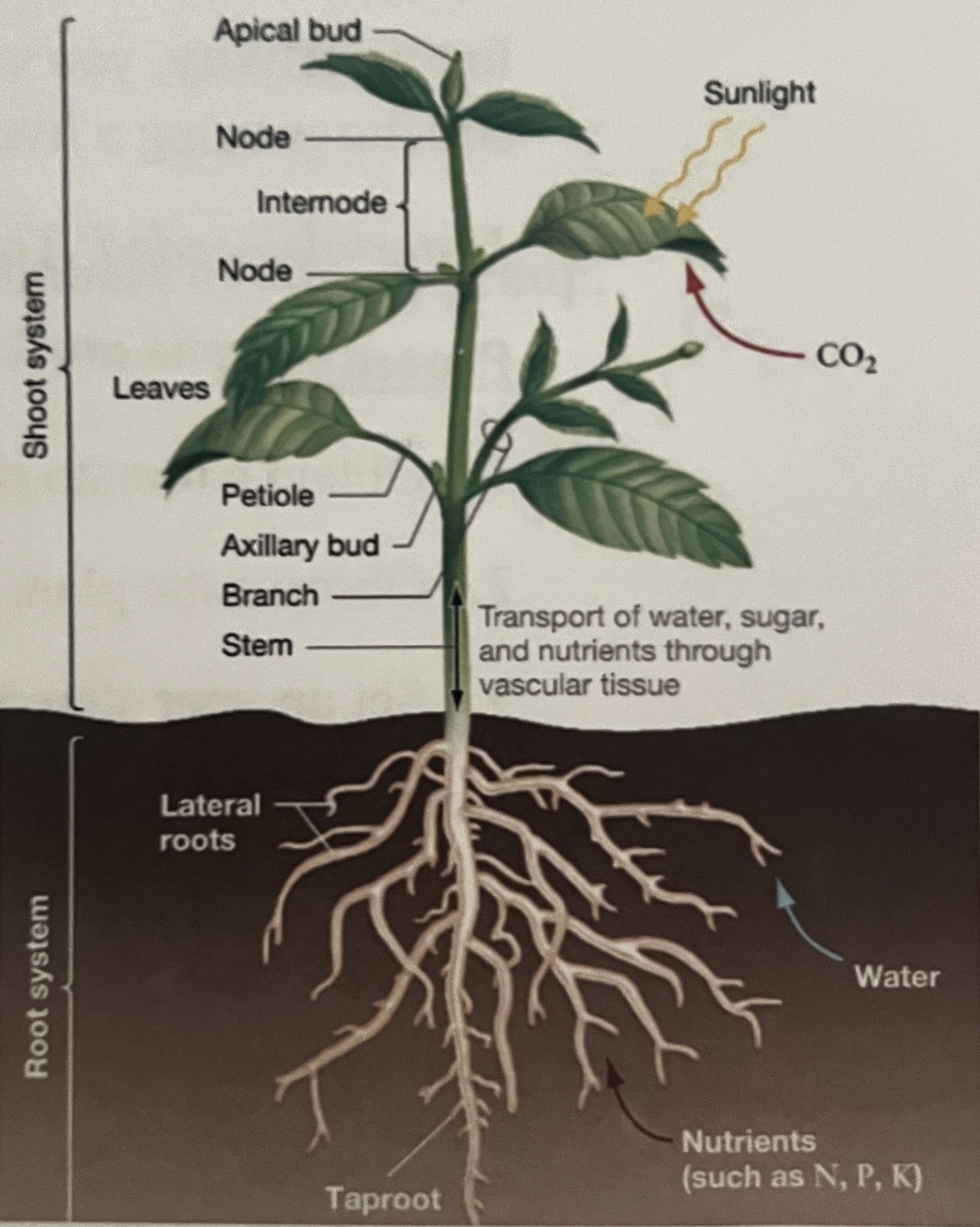
What is the function of the Trichome on an Angiosperm?
They may limit water loss by reducing evaporation, and protecting the plant from the enviornment and predators.
What is a Trichome?
Small hair-like projections on the leave of an angiosperm, which may limit water loss by reducing evaporation, and protecting the plant from the enviornment and predators.
What are the three tissue systems of a Plant?
Dermal - the epidermis, outer-most layer of cells
Ground - site of most photosynthesis and carb storage
Vascular - responsible for long-distance transport of water and nutrients
What is Dermal Tissue, and what is its function?
It consists of the epidermis, outer-most layer of cells which provides protection to the shoots and leaves and absorbs water and nutrients in the roots
Cuticle, Trichome, Stoma, and Guard cells are the structures that make up ground tissue
What are the structures that make up Dermal Tissue?
Cuticle - waxy outer layer that reduces water loss
Trichome - hair like extensions
Stoma
Guard Cells - which open and close to allow CO2 to enter
What is Ground Tissue, and what is its function?
The site of most photosynthesis and carbohydrate storage
In the stem and root systems, this tissue may be referred to as the Cortex and Pith
three cell types make up this tissue, Parenchyma, Collenchyma, and Selerenchyma
What are the Cells that make up Ground Tissue?
Three cell types make up Ground Tissue:
Parenchyma - responsible for photosynthesis in leaves, and carb storage such as starch
Collenchyma - often found in stems to help make the plant flexible to withstand bending
Selerenchyma - they are dead at maturity and provide firm support for stems, and the hard coating of seeds and nuts
What is Vascular Tissue, and what is its function?
Is responsible for the long-distance transport of water, nutrients, and photosynthetic products
consists of two tissues, Xylem and Phloem
What are the structures that make up Vascular Tissue?
Consists of two tissues
Xylem - transports water and dissolved nutrients in only one direction
Phloem - moves sugar and other substances in two directions
What are Cuticles, and their function?
The waxy outer layer that reduces water loss in the stem and leaves
make up the dermal tissue system
What are Trichomes, and their function?
Specialized epidermial cells that are the hair-like projections that cover the leaf and primarily serve as a defense mechanism, or limit water loss
make up the dermal tissue system
What are Stomata, and thier function?
Apart of the dermal tissue system, they are tiny pores that allow CO2 to enter for photosynthesis when they are open. And when they are closed, they protect the plant from water loss due to evap.
make up the dermal tissue system
What are Guard Cells, and thier function?
Specialized dermal tissue cells that surround the Stomata, and control the opening and closing of Stomata which regulate CO2 exhange and water transpiration (water losses)
make up the dermal tissue system
What are Parenchyma Cells, and thier functino?
The cells in leaves that contain chloroplasts responsible for photosynthesis
And in roots, the cells store carbohydrates, such as starch
make up the ground tissue system
What are Collenchyma Cells, and thier function?
Cells that have the ability to stretch, making the stem felxible to withstand bending
make up the ground tissue system
What are Selerenchyma Cells, and thier function?
Cells that are dead at maturity, which provide firm support for stems and provide the hard coat of seeds and nuts
make up the ground tissue system
What is Xylem, and their function?
Vascular tissue that transports water and dissolved nutrients only in one direction, from the roots to the stem and leaves
make up the vasculr tissue system
What is Phloem, and their function?
Moves sugar and other substances in two directions, and make up the sieve-tube elements and companion cells
make up the vascular tissue system
What are the four basic Organs of the flower?
Sepals - modified leaves at the base of the flower
Petals - brightly colored to attract pollinators
Stamen - reproductive structure that produces male gametophytes
Carpel - produces female gametophytes
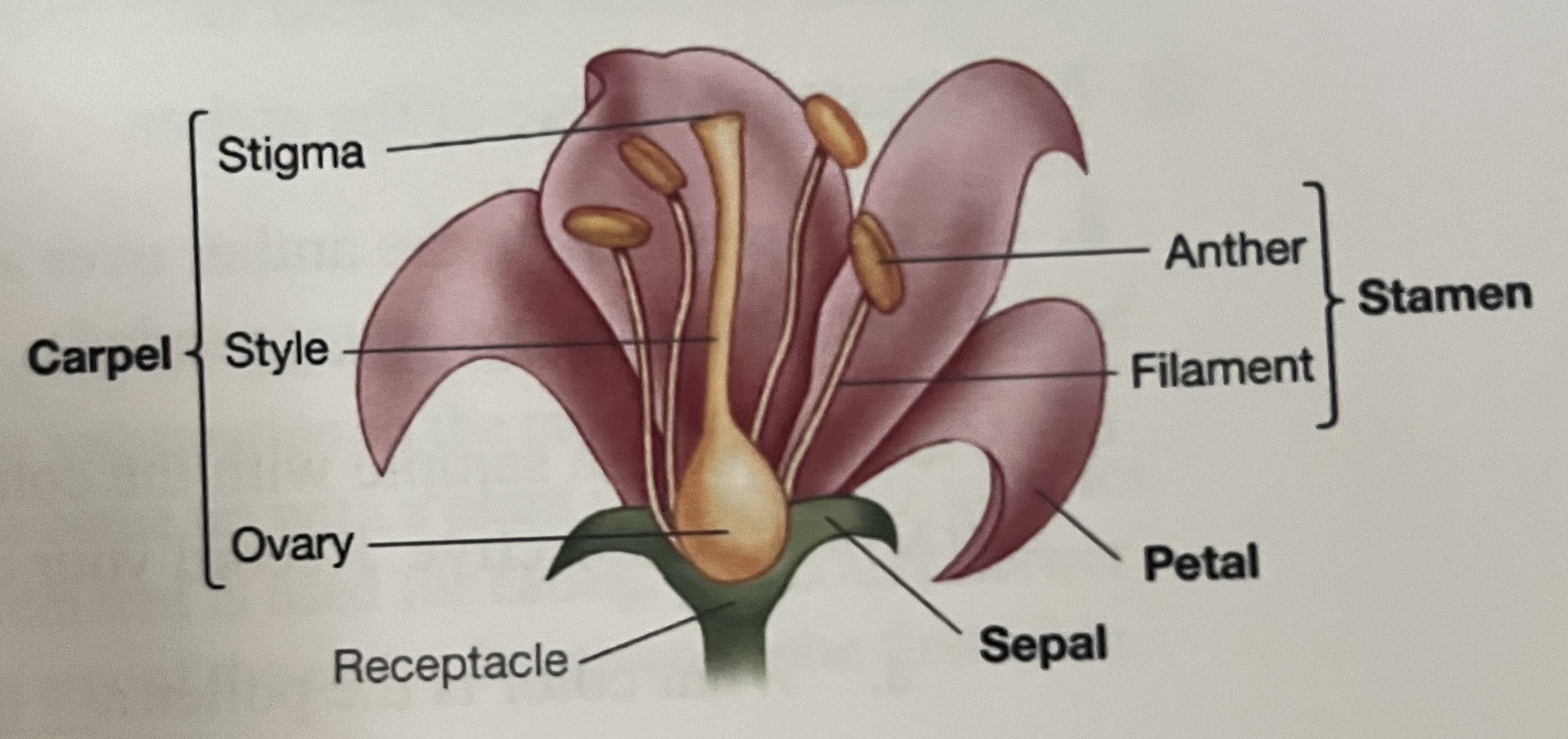
What is the Stamen of a Flower?
Is the reproductive organ that produces male gametophytes (pollen grains)
Anther, Filament, and Pollen make up the Stamen
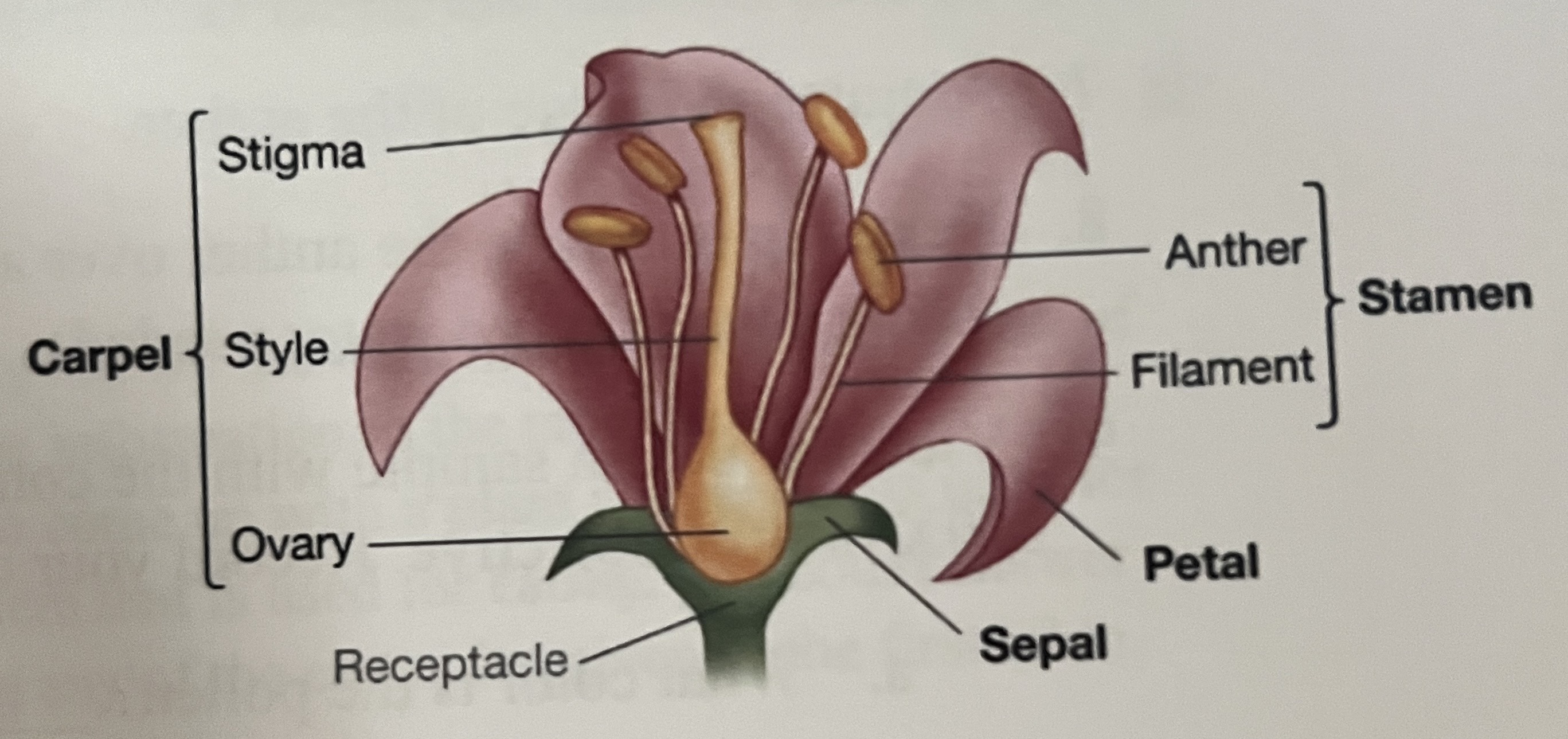
What is the Carpel of a Flower?
Reproducvitve organ that produces female gametoyphyes, which matures to form eggs
Stigma, Style, and Ovary make up the Carpel
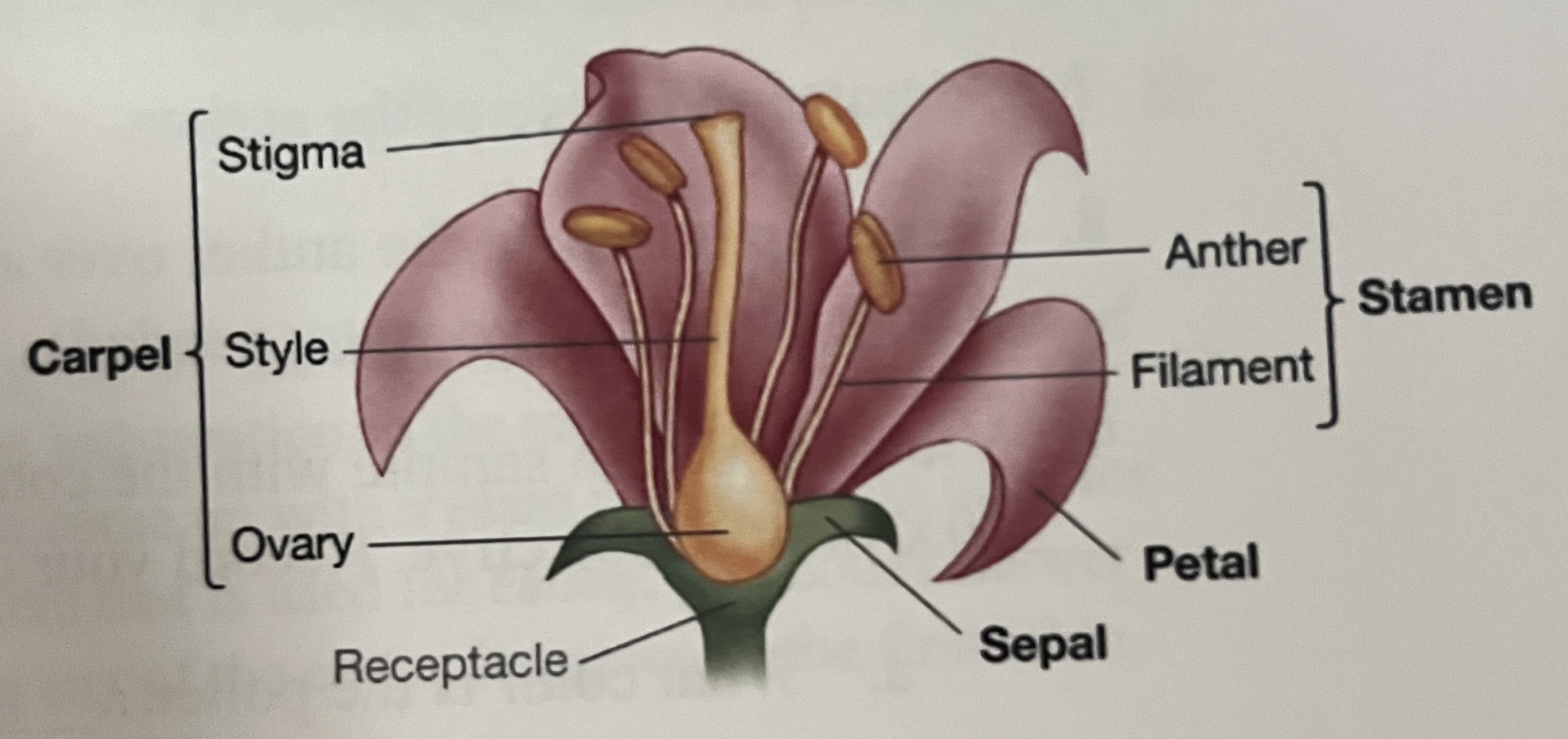
What are the Sepals of a Flower?
The modified leaves at the base of the flower, that protect the flower bud during development
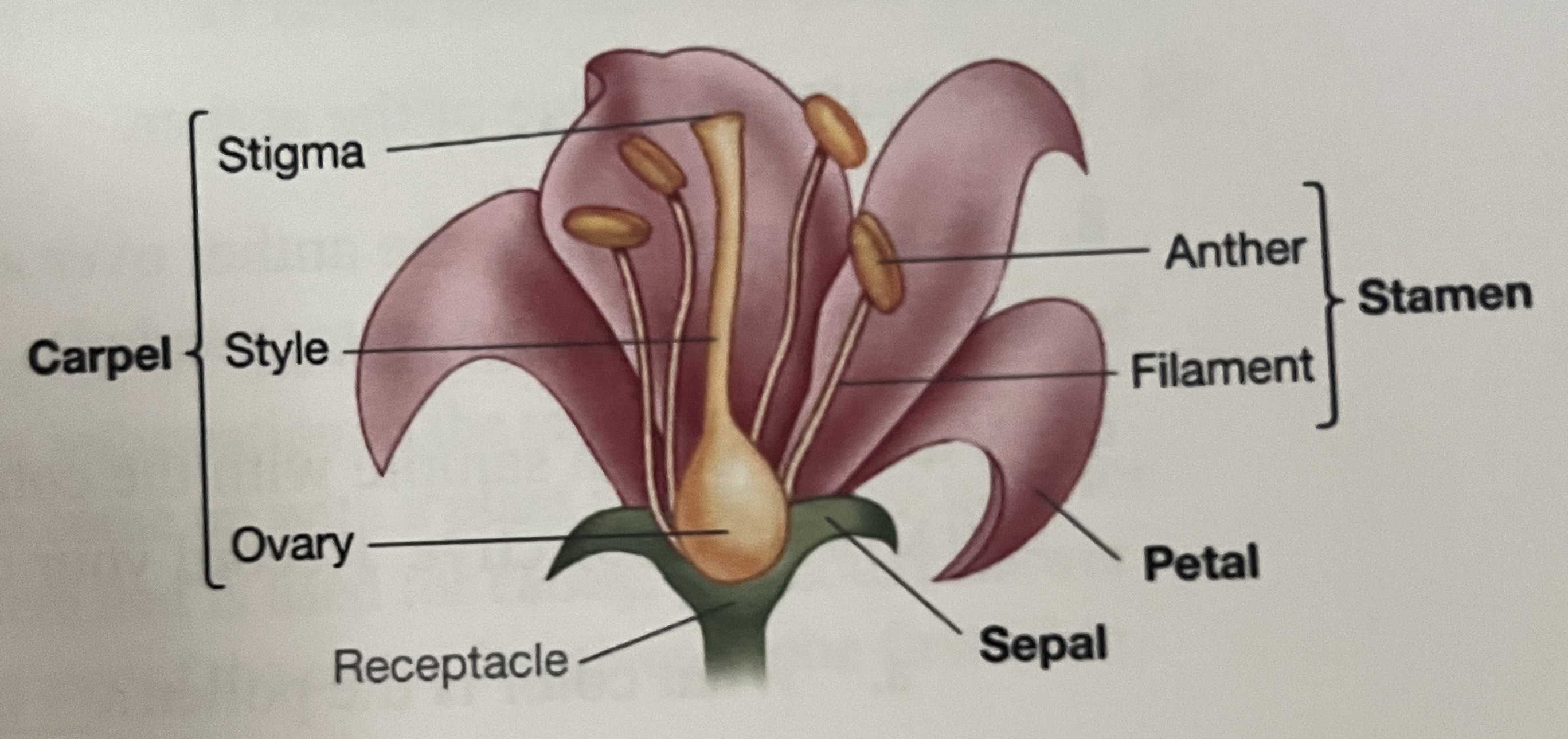
What are the components that make up the Carpel on a flower?
Stigma
Style
Ovary
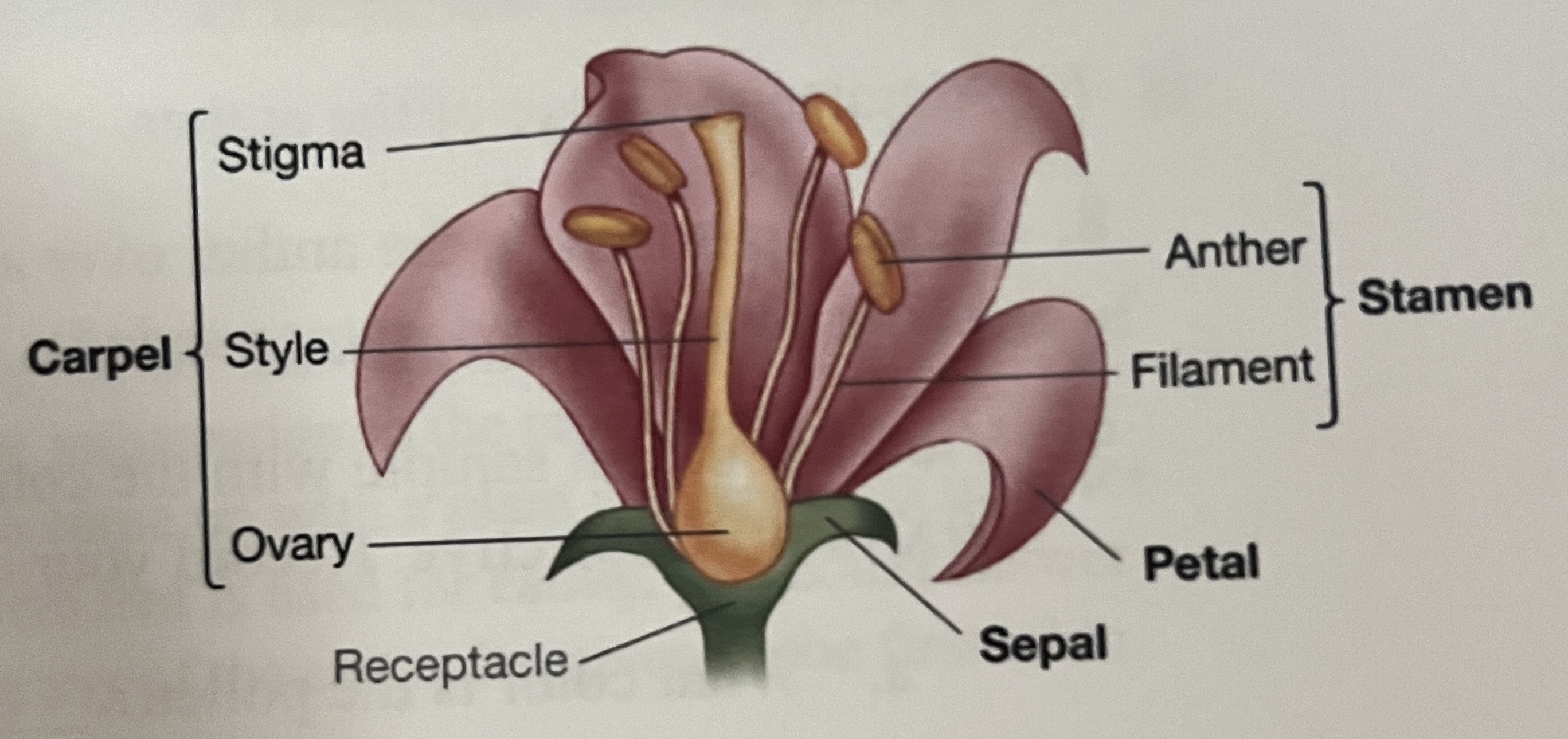
What are the components that make up the Stamen on a flower?
Anther
Filament
Pollen
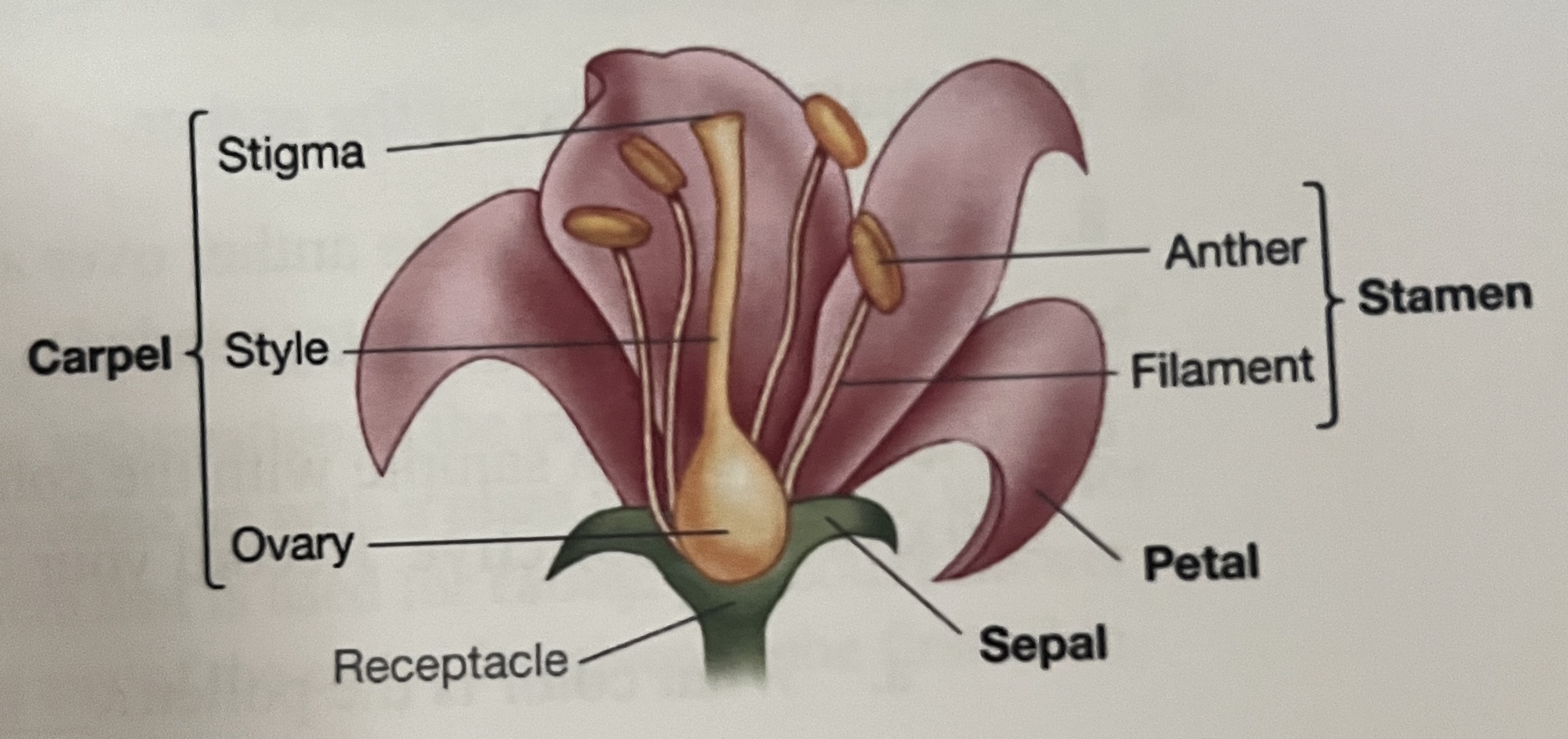
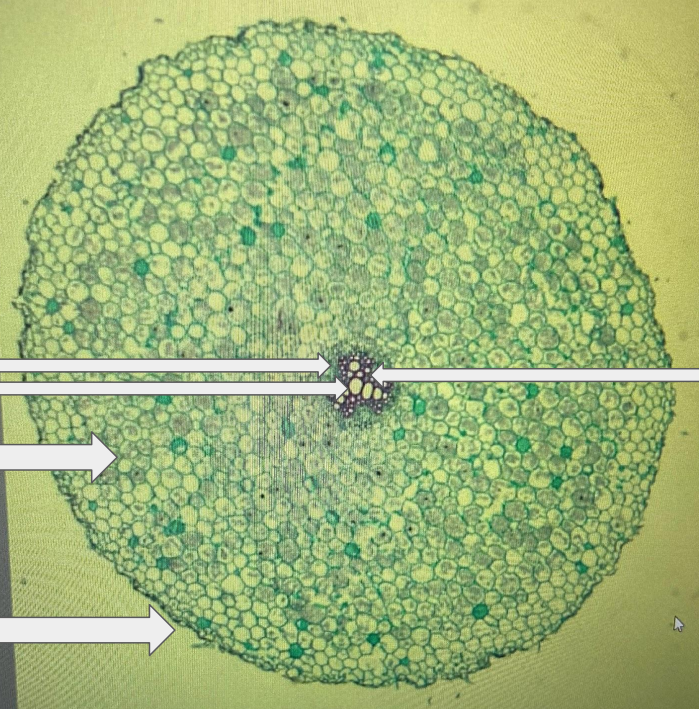
In this image, identify the Endodermis, Xylem, Cortex, Phloem and Epidermis (root cross-section)
Epidermis
Cortex - ground tissue between the epidermis and center vascular tissue
Endodermis - surrounds phloem and xylem
Phloem - surrounds the xylem
Xylem - found in the cener (cross shapr)
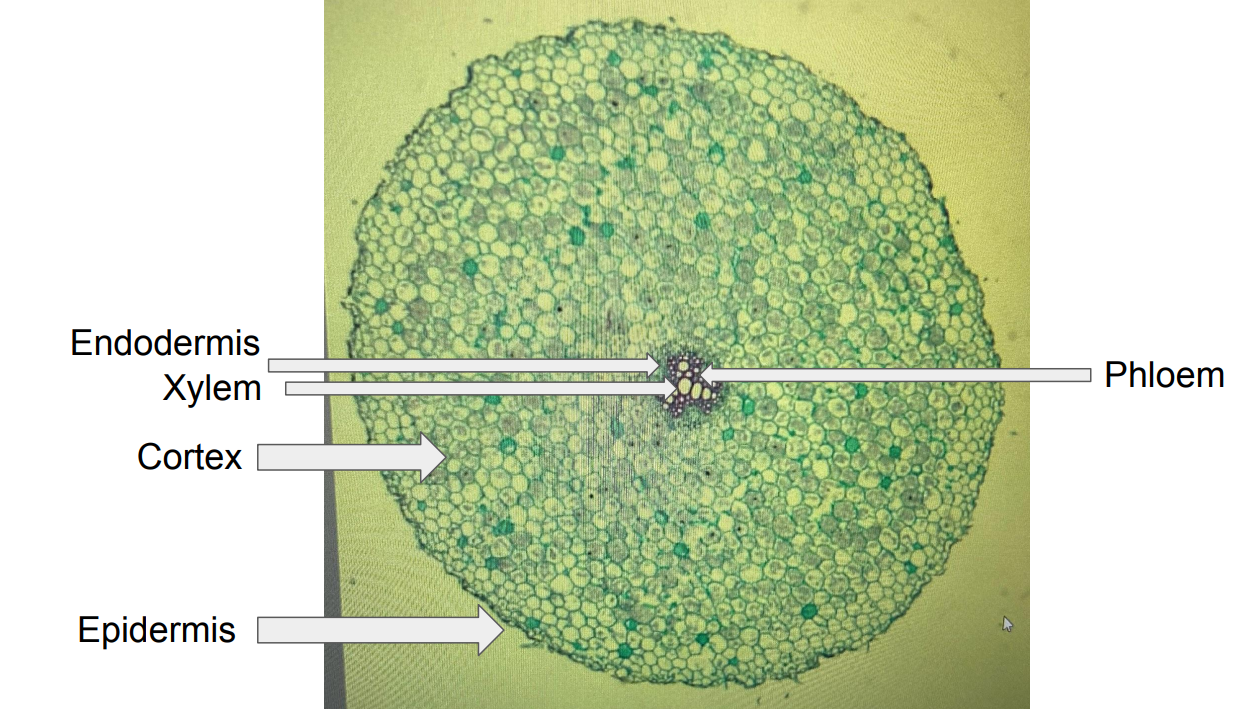
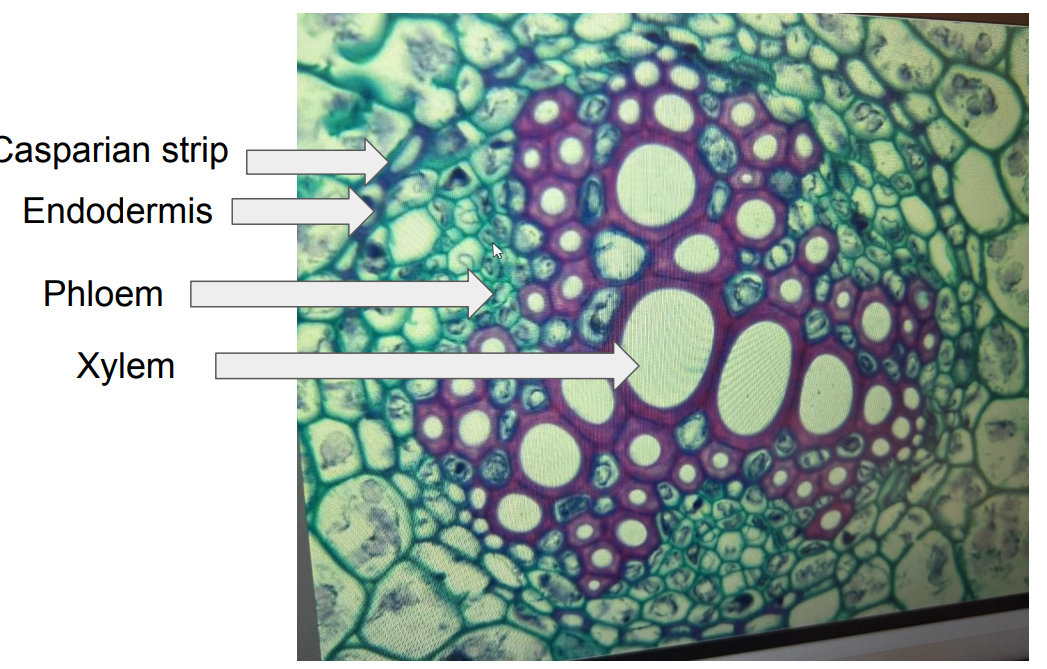
In this image, identify the Casparian Strip, Phloem, Xylem, and Endodermis (root cross-section)
Casparian Strip
Endodermis
Phloem
Xylem
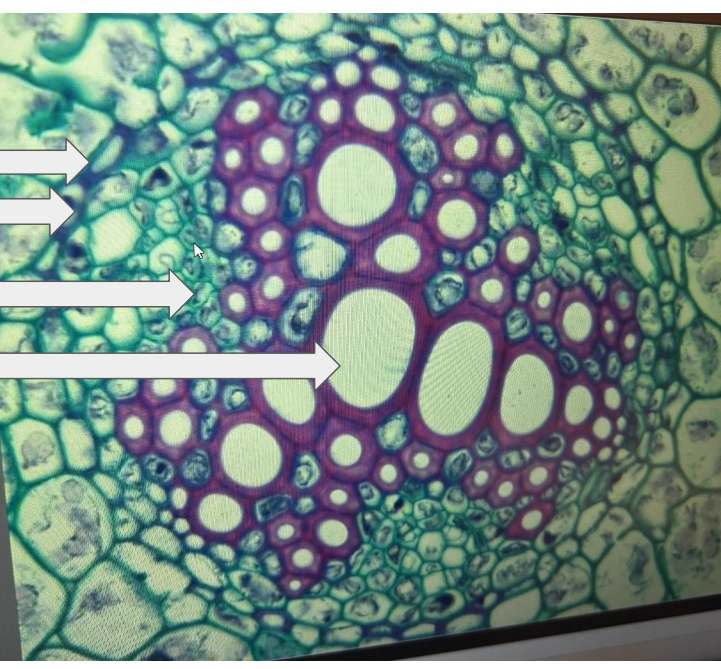
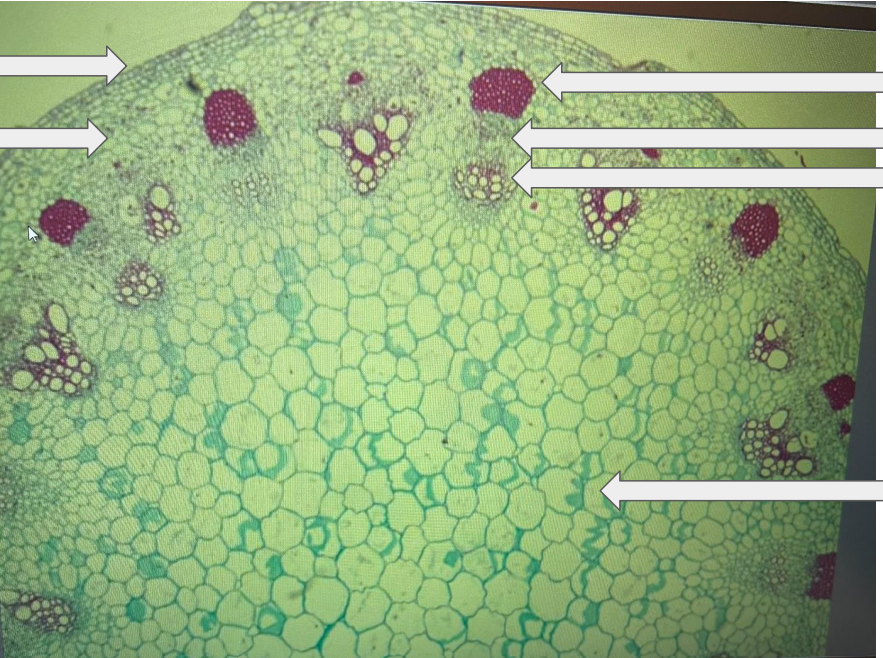
In this image, identify Cortex, Epidermis, Xylem, Phloem, Fibers and Pith (stem cross-section)
Epidermis - ouer layer
Cortex - ground tissue between epidermis and vascular bundles
Fibers
Phloem
Xylem
Pith - ground itssue on the inside of the stem
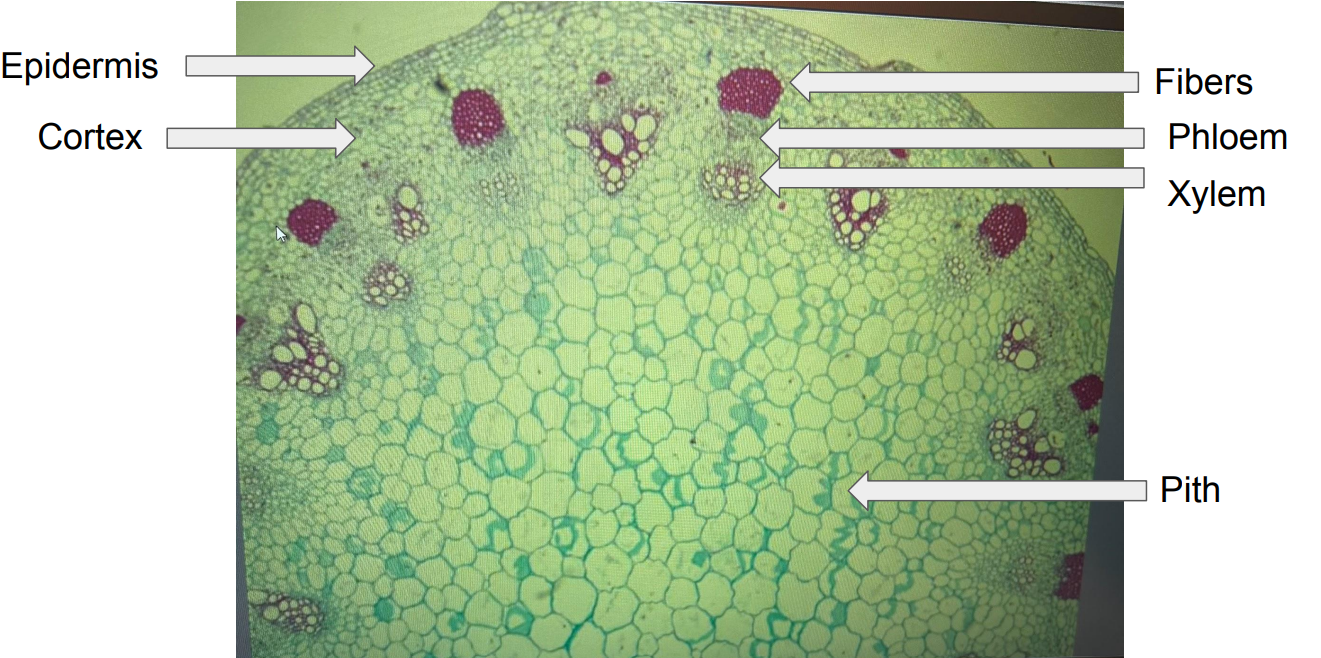
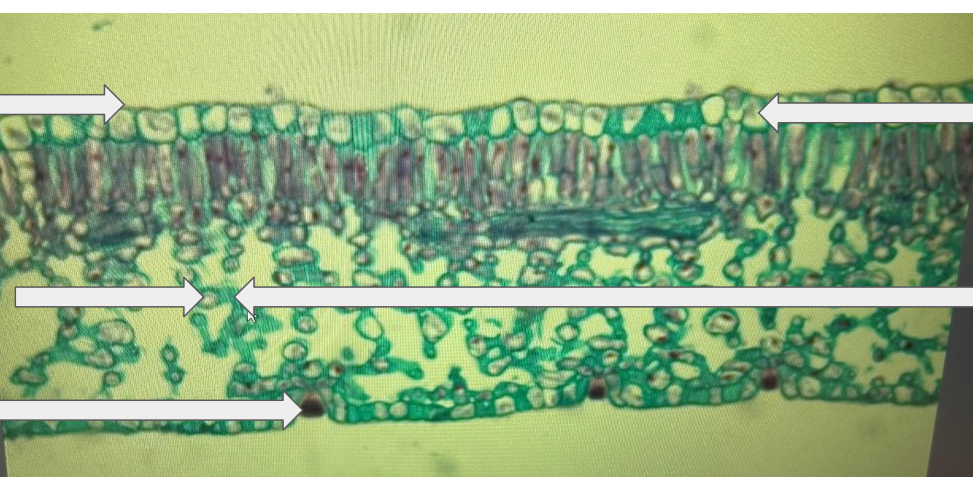
In this image, identify Xylem, Phloem, Epidermis, Cutcile, and Guard Cells (leaf cross-section)
Cuticle - waxy layer on outer surface
Epidermis
Phloem
Xylem
Guard Cells - have a physical gap between them, and surround the stomata
Parenchyma - area between the epidermis and vascular bundles

In this image, identify the Pore, Guard Cells, and Chloroplast
Pore
Chloroplast
Guard Cells

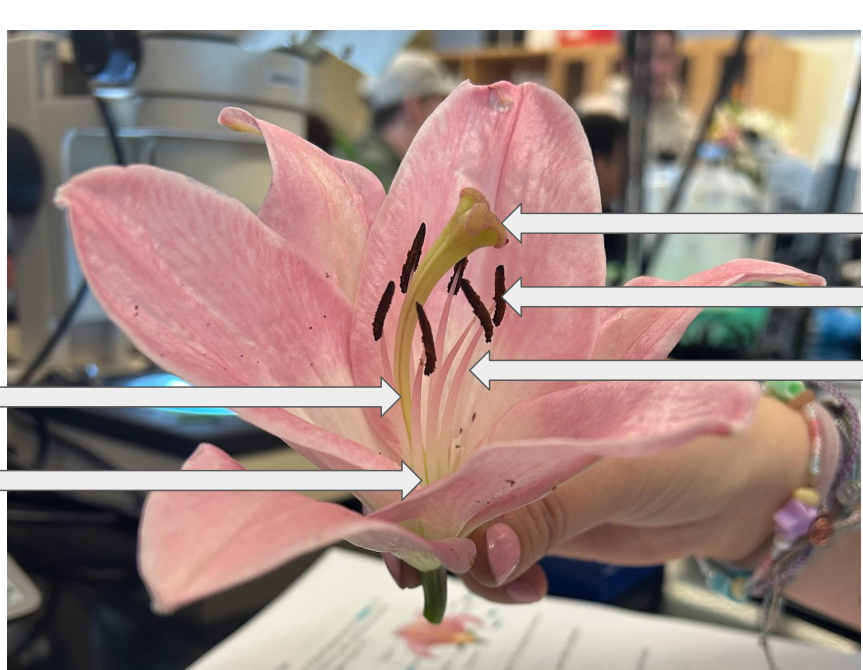
Identify the components that make up the Carpel and Stamen in this image
Carpel :
Stigma - top portion of carpel
Style - stalk that hold the stigma
Ovary
Stamen :
Anther - produces pollen
Filament - stalk that holds the anther
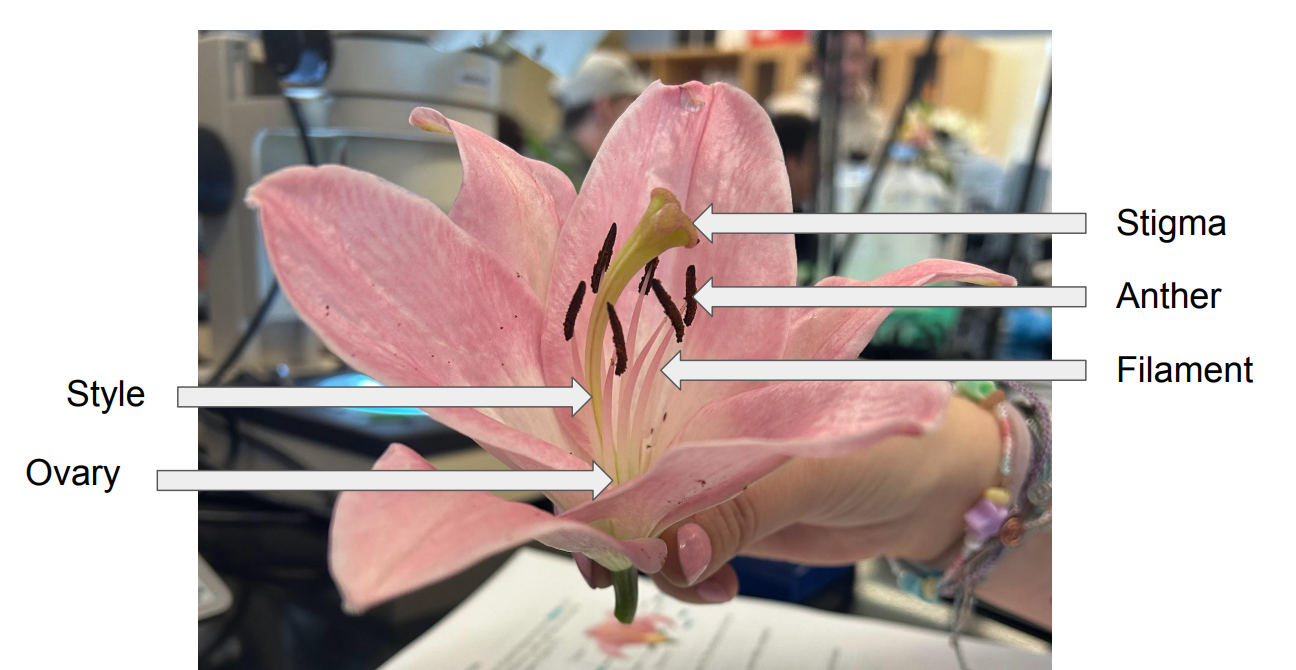
What is Transpiration?
Is the process where plants release water vapor through tiny pores on thier leaves
How does Transpiration occur?
Plants absorb water upward from the roots and travel through the Xylem transport system to the leaves
Stomata open to allow CO2 to enter for photosynthesis and water vapor also escapes
Transpiration is driven by a concentration gradient
Why do plants Transpire?
Primarily to cool down and facilitate nutrient uptake
How does Transpiration work as a Concentration Gradient?
When there is a higher concentration of water in the air within the leaf pore than in the atmosphere, water vapor will and exit the leaf and move into the atmosphere
How was the leaf impression created using nail polish?
paint clear nail polish on the leaf
after drying, use clear packing tape to peel the polish off the leaf
and it provides an impression of the leaf
This allows you to observe the outlines of the epidermal cells and stomata
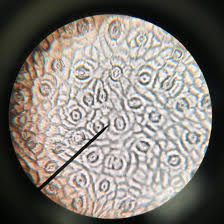
In this image what are the Stomata?
The oval shapes with a dot in the middle

How do you calculate the % distibution of Stomata on top and bottom leaf surfaces?
(# of stomat counted on that specific surface / total # of stomata on both surfaces) * 100
Explain how measuring pressure in the tube attached to the cut stem can provide information about the transpiration rate of the plant?
As the plant transpires, it draws up water from the tubing and expands the air pocket.
As the volume of the air pocket increases, the pressure within it decreases.
This decrease in pressure is proportional to the rate of transpiration (water uptake)
What does the volume in the air pocket coorelate to in Plant Transpiration?
As the volume in the air pocket increases, the pressure within it decreases (is measured in kPa)
What data was directly collected vs what was calculated in Plant Transpiration?
The data collected/measured was pressure change over time (kPa/sec)
the data calculated from that data was the transpiration rate (volume over time μl/min)
What does kPa/sec stand for?
Pressure change over time (what was measured in Plant Transpiration)
What does μl/min stand for?
Transpiration Rate - volume over time
(what was calculated from kPa/sec data)
What are some errors that could lead to the pressure not decreasing in Plant Transpiration?
two-way valve is closed
there are bubbles in the water-filled portions of the tubing setup
the adaptor peice is too large for the stem, and theres not a tight seal
the adaptor is loose around the tubing
How do you calculate mean transpiration rates?
You have to convert kPa/sec into kPa/min (*60)
Convet pressure rates (kPa/min) into volume transpiration rate (1 kPa decrease = 20 μl, so *20)
Then calculate the mean for the values
How do you calculate % change in Mean Transpiration Rates?
% change = [(MTR when bottom surface was coated - MTR with no leaf coating) / MTR with no leaf coating] *100
What is the effect of coating the bottom surface of the leaf with oil on the transpiration rate, and why?
Coating the leaf significantly reduces the rate of transpiraiton, because the oil acts as a barrier blocking the stomata and preventing water vapor from escaping
What is the relationship between the % change in transpiration rate to the % distribution of stomata on leaf surfaces?
A greater % of stomata on a leaves surface leads to a higher rate of transpiration.
If there are more stomata, there are more pathways for water to exit the leaf, increasing transpiration
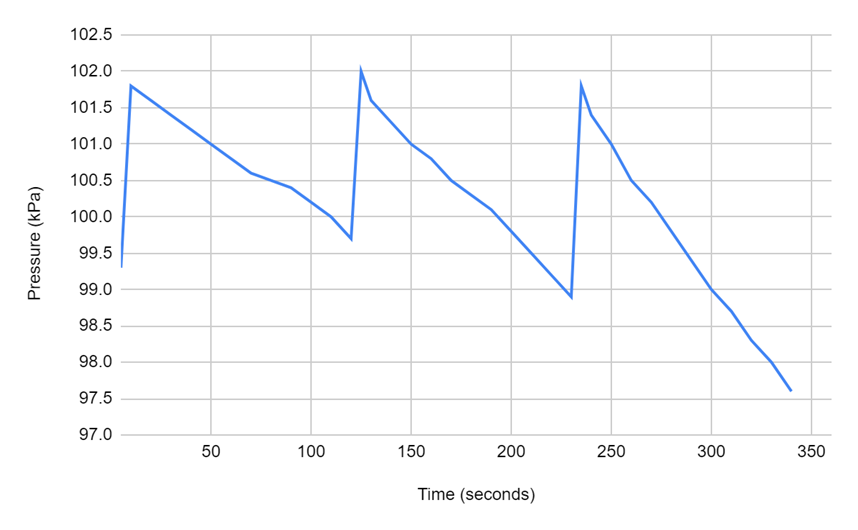
Analyze the results of this Transpiration experiment, and interpret it
The transpiration rate is increasing over the three two-minute periods.
The transpiration rate over the third period decreases more rapidly when compared to the first period, which again suggests an increase in transpiration rate.
Explain the difference between exponential and logistic growth, in terms of what conditions produce each
Exponential growth occurs when a population increases at an accelerating rate, under ideal conditions w/ unlimited resources
Logistic growth occurs when population growth slows down as it approaches the environment's carrying capacity
How does population growth rate change with population size (related to graphs)?
In exponential growth, as population size increases, growth rate also increases leading to a steeper curve
In logistic growth, growth rate initially increases with size, but then slows down as the population reaches its carrying capacity
What is Carrying Capacity?
The maximum number of individuals of that species that the enviornment can support at that time
determined by the limitied avaliabilty of food, nutrients, or space
What determines Carrying Capacity for a population?
The limited avaliability of important resources such as food, nurients, or space